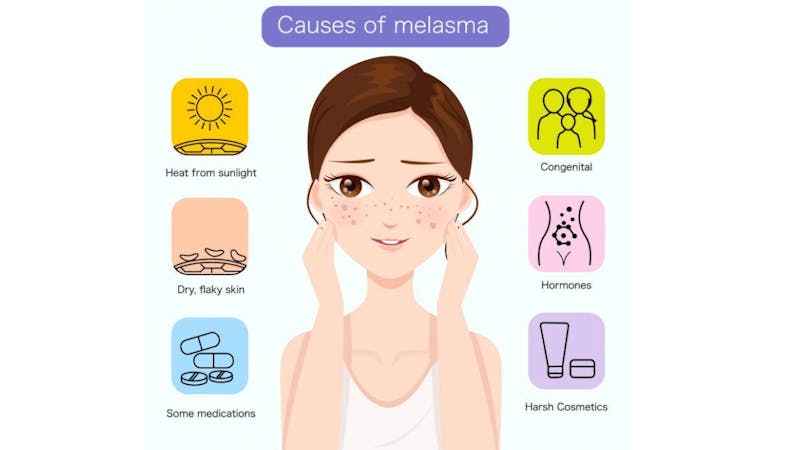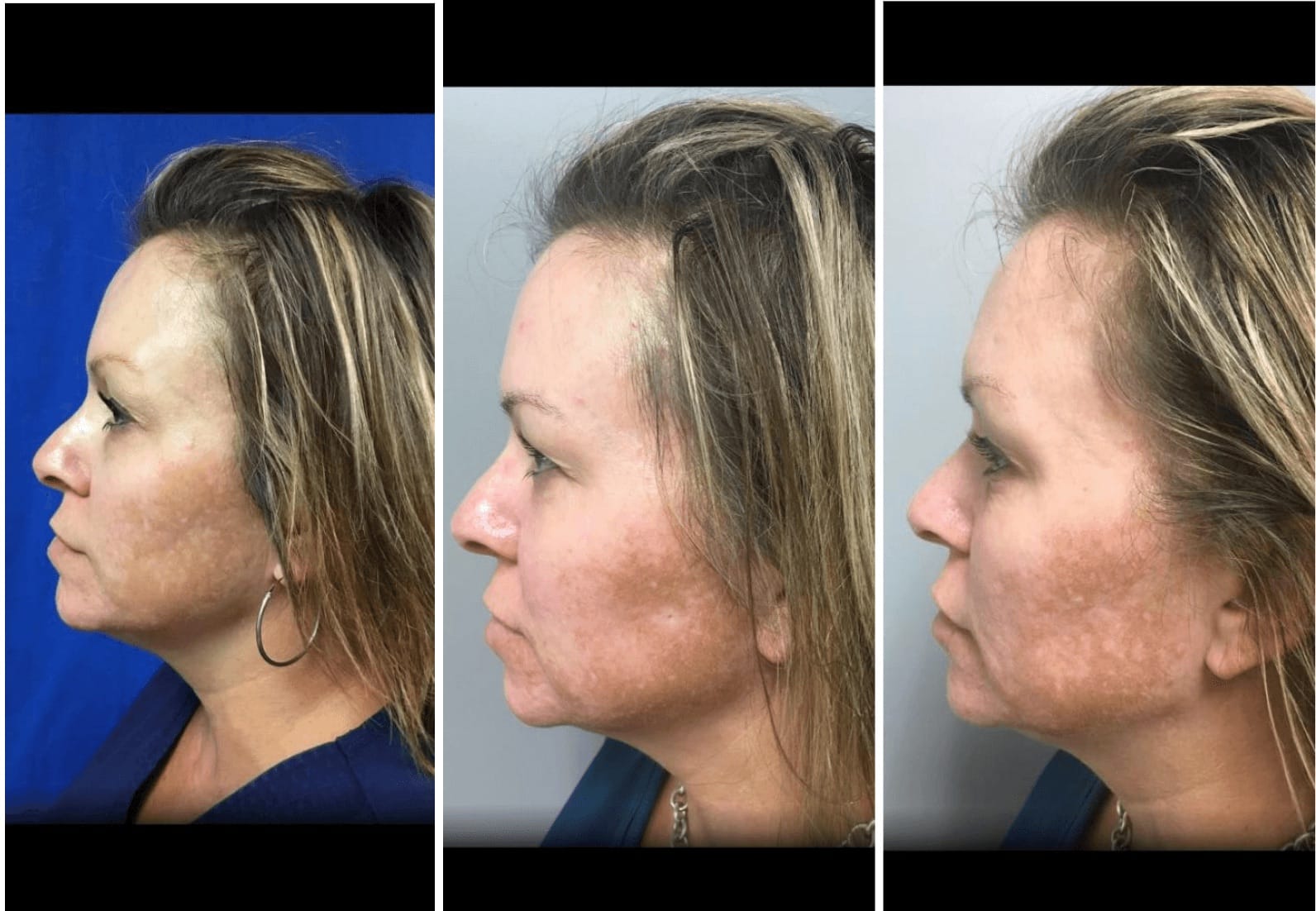
July is Hyperpigmentation and Melasma Awareness month, so we went to our Resident Expert, Franki the Aesthetician, for the scoop on what it is and how to treat it. Franki also struggled with melasma (check out her pics later in this blog) so she is “in the know” of what works and what doesn’t.
The primary symptom of melasma is hyperpigmentation. It is a stubborn condition that affects more than 5 million people with approximately 90% of them being women. It’s treated on an individual basis since each case can be so different. However, we do have specific recommendations for medical grade skincare, in-office treatments, and preventative steps that have successfully helped many patients.
So, what Is Melasma?
According to The American Academy of Dermatology melasma is a pigmentary condition that causes gray-brown patches, usually on the cheeks, bridge of the nose, forehead, chin and above the upper lip (a.k.a. the “melasma mustache”). While we often see melasma on the face, melasma can also appear on other parts of the body that are exposed to the sun, like the forearms and neck. It can change the way your skin looks (and maybe mess with your confidence levels too!).
What Are the Causes of Melasma?
Melasma can be caused by a combination of factors such as sun exposure, hormones, and genetics.
Much like other forms of hyperpigmentation, melasma is exacerbated by exposure to the sun. Ultraviolet (UV) light from the sun stimulates melanocytes (color-producing cells in the skin) to produce too much pigment, resulting in those previously mentioned gray-brown patches on the face. Melasma is often worse in the summer as we spend more time outside in the sun.
In addition to sun exposure, hormones seem to trigger melasma. Up to 70% of pregnant women suffer with melasma from pregnancy, and the condition is sometimes referred to as the “mask of pregnancy.” Hormonal contraceptives and other hormone therapies can also instigate melasma.
People with darker skin (such as those with Latin/Hispanic, African American, Asian, Indian or Middle Eastern descent) are more likely to get melasma as they have more active melanocytes than people with lighter skin. People who have a blood relative who had melasma are also more likely to get melasma. Who knew!
Medical Grade Treatments You Can Use at Home
It’s important to treat melasma with a medical-grade skincare regimen that combines multiple brightening actives like vitamin C, vitamin E, arbutin, kojic acid and glycolic acid, to subdue the overactive pigment cells and eliminate the excess pigment that is already in the skin. Over the counter products are highly diluted and not strong enough to treat this condition. Prescription hydroquinone can be added for more severe cases.
Keep in mind, once you start seeing progress with your skin, that is not the time to ease up on your lineup. Persistence with these key ingredients is crucial for long-term results and to prevent the return of hyperpigmentation.
Franki recommends several medical grade products (used over the course of at least three months) to treat melasma (and help keep it at bay). Prescription strength Retinol products can also be considered to help.
ZO Skin Health Brightalive Skin Brightener
- Helps to fade the size and intensity of dark spots
- Improves luminosity, clarity and overall skin quality
- Delivers lightweight hydration
- Mild, gentle formula
ZO Skin Health 10% Vitamin C Serum (Daytime Use)
- Brightens and redefines the skin
- Corrects existing pigment and prevents future pigment
- Provides multiple antioxidant protection
- Minimizes the appearance of fine lines and wrinkles
ZO Skin Health Pigment Control/Blending Cream
- Optimizes the delivery of active ingredients to the skin
- Helps even skin tone
- Helps reduce irritation associated with hydroquinone
- Hydrates newly exposed skin
- Provides gradual lightening of hyperpigmentation skin
ZO Skin Health Exfoliating Polish
- Physically exfoliates off dead skin cells and other debris to improve skin radiance
- Magnesium oxide crystals wash away clean, leaving skin instantly soft and smooth
Franki’s Melasma Pictures


How do I Treat Melasma?
Melasma is difficult to treat (and often depends on severity), but there are ways to tackle this stubborn pigmentary condition.
In-office treatments for melasma can serve as a strong jumpstart on your journey to glowing skin. They can also be a tool for maintenance or of course, an amazing complement to your at-home treatments.
Sciton Halo Laser Treatments - Dramatically fast forward your results by 6 months or more. However, melasma can recur after Halo if you do not follow the rules. It doesn’t completely disappear because it is considered a “condition” that needs to be maintained.
Platelet-Rich Plasma + Microneedling (aka Vampire Facial)- PRP treatments utilize your blood’s platelets which are loaded with growth factors that initiate the healing process in the body. One of the growth factors released from platelets has been shown to have a dose dependent effect on inhibiting the enzyme that creates melanin, therefore decreasing melasma. PRP treatments can also increase skin volume and tone, resulting in more “glowing skin”, countering the effects of melasma.
Treatments may need to be repeated to maintain optimal long-term results and maximum effect. And again, active skincare can help you sustain your glow and keep melasma at bay!
How to Prevent Melasma?
According to the American Academy of Dermatology, one of the most common and effective treatments for melasma is sun protection. This means wearing sunscreen daily and reapplying every two hours (even if you’re just sitting by a window or the day is cloudy), as well as wearing a wide-brimmed hat and avoiding being in direct sunlight at its strongest points in the day. Just a small amount of sun exposure can make melasma return after it has faded! Imagine spending a year of your time, money, and dedication on your melasma battle, only to have it completely ruined after one careless day in the sun. Don’t let this happen to you!
While it may seem impossibly tricky and incredibly stubborn, there is hope to treat this condition. Between brightening ingredients, skincare services and vigilant sun prevention, you can take on your melasma and win!
Give us a call at (804) 378-7443 and schedule a complimentary consultation with Franki, Licensed Medical Aesthetician, to begin your journey to your best skin!



